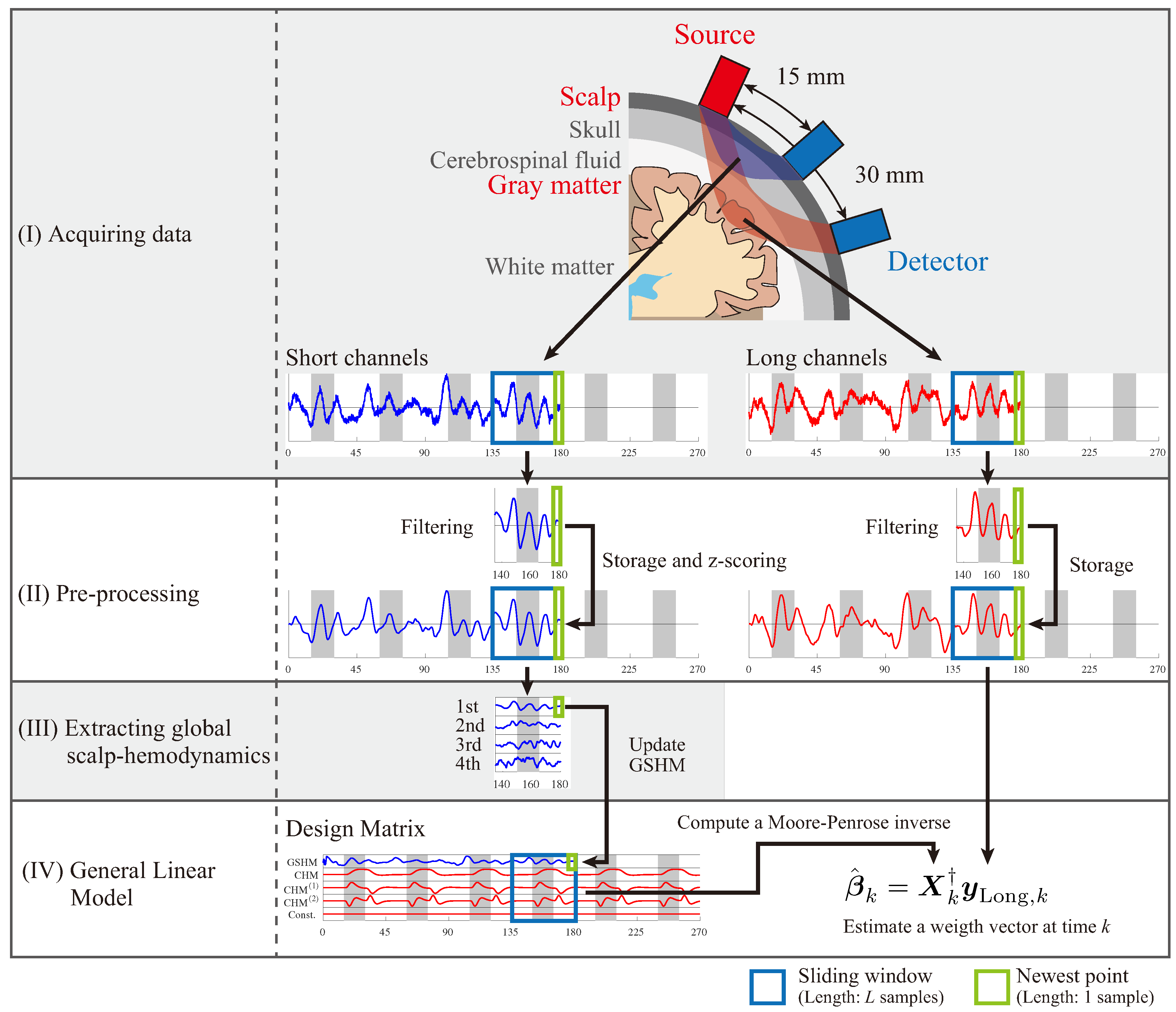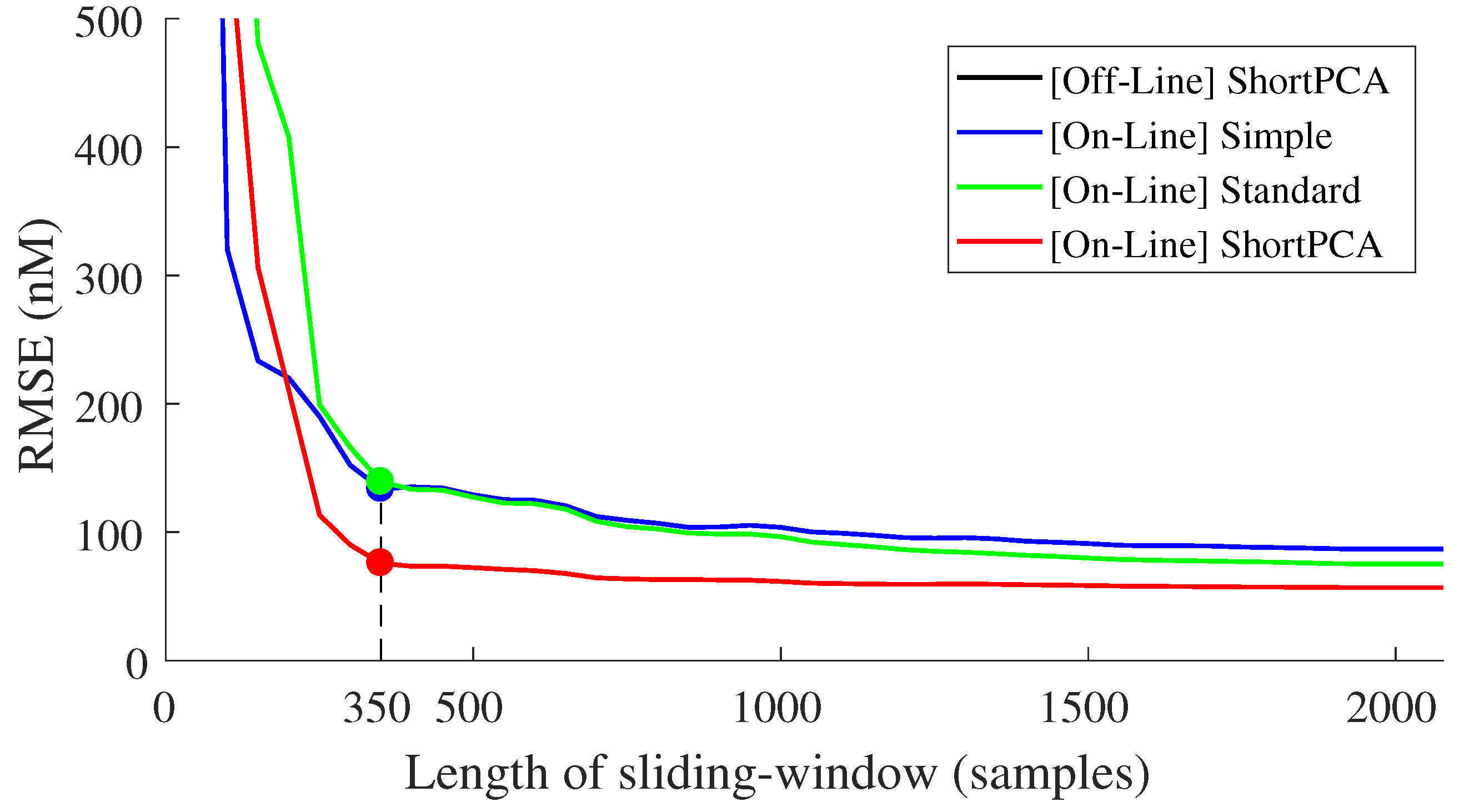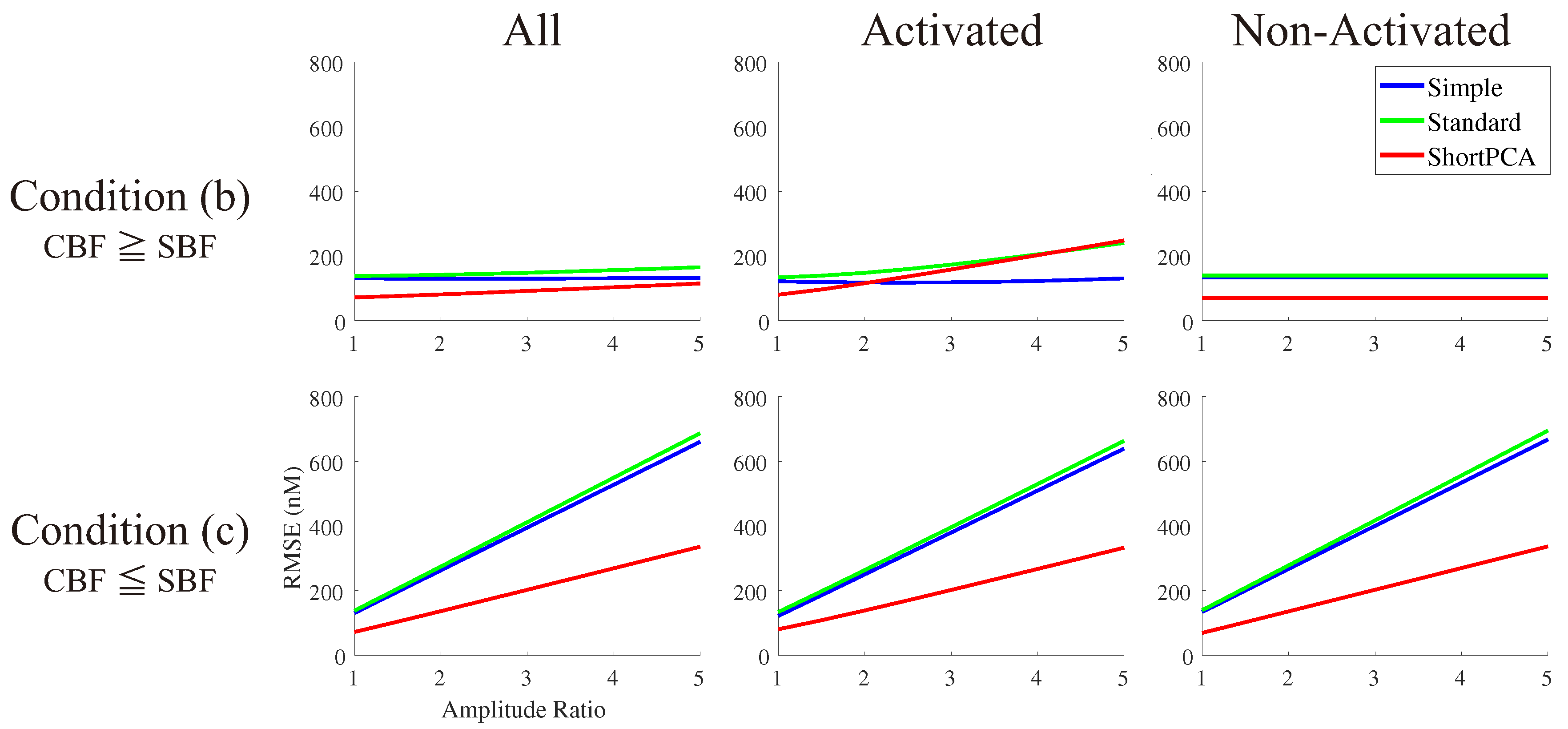Real-Time Reduction of Task-Related Scalp-Hemodynamics Artifact in Functional Near-Infrared Spectroscopy with Sliding-Window Analysis
Abstract
1. Introduction
2. Methods
2.1. Sliding-Window Analysis
2.2. Real-Time Signal Processing
3. Semi-Real Simulation
3.1. Artificial Functional Near-Infrared Spectroscopy (fNIRS) Signals
3.2. Performance Evaluation
4. Results
4.1. Performance Comparison
4.2. Performance of Several Window Length
4.3. Performance under Several Cerebral- and Scalp-Hemodynamics Amplitude Ratios
5. Discussion
5.1. Advantages of Proposed Method
5.2. Effect of Sample Length of Sliding-Window
5.3. Limitations
6. Conclusions
Acknowledgments
Author Contributions
Conflicts of Interest
Abbreviations
| CBF | Cerebral Blood Flow |
| CHM | Cerebral-Hemodynamics Model |
| CHM | Temporal derivative of CHM |
| CHM | Dispersion derivative of CHM |
| fNIRS | functional Near-Infrared Spectroscopy |
| fMRI | functional Magnetic Resonance Imaging |
| GLM | General Linear Model |
| GSHM | Global Scalp-Hemodynamics Model |
| PCA | Principal Component Analysis |
| SBF | Scalp Blood Flow |
| SWA | Sliding-Window Analysis |
References
- Naseer, N.; Hong, K.S. fNIRS-based brain-computer interfaces: A review. Front. Hum. Neurosci. 2015, 9, 1–15. [Google Scholar] [CrossRef] [PubMed]
- Abdelnour, A.; Huppert, T.J. Real-time imaging of human brain function by near-infrared spectroscopy using an adaptive general linear model. NeuroImage 2009, 46, 133–143. [Google Scholar] [CrossRef] [PubMed]
- Fazli, S.; Mehnert, J.; Steinbrink, J.; Curio, G.; Villringer, A.; Müller, K.R.; Blankertz, B. Enhanced performance by a hybrid NIRS-EEG brain computer interface. NeuroImage 2012, 59, 519–529. [Google Scholar] [CrossRef] [PubMed]
- Kober, S.E.; Wood, G.; Kurzmann, J.; Friedrich, E.V.; Stangl, M.; Wippel, T.; Väljamäe, A.; Neuper, C. Near-infrared spectroscopy based neurofeedback training increases specific motor imagery related cortical activation compared to sham feedback. Biol. Psychol. 2014, 95, 21–30. [Google Scholar] [CrossRef] [PubMed]
- Mihara, M.; Miyai, I.; Hattori, N.; Hatakenaka, M.; Yagura, H.; Kawano, T.; Okibayashi, M.; Danjo, N.; Ishikawa, A.; Inoue, Y.; et al. Neurofeedback using real-time near-infrared spectroscopy enhances motor imagery related cortical activation. PLoS ONE 2012, 7, e32234. [Google Scholar] [CrossRef] [PubMed]
- Ung, W.C.; Funane, T.; Katura, T.; Sato, H.; Tang, T.B.; Mohammad Hani, A.F.; Kiguchi, M. Effectiveness Evaluation of Real-time Scalp Signal Separating Algorithm on Near-infrared Spectroscopy Neurofeedback. IEEE J. Biomed. Health Inform. 2017. [Google Scholar] [CrossRef] [PubMed]
- Kirilina, E.; Jelzow, A.; Heine, A.; Niessing, M.; Wabnitz, H.; Brühl, R.; Ittermann, B.; Jacobs, A.M.; Tachtsidis, I. The physiological origin of task-evoked systemic artefacts in functional near infrared spectroscopy. NeuroImage 2012, 61, 70–81. [Google Scholar] [CrossRef] [PubMed]
- Huppert, T.J.; Diamond, S.G.; Franceschini, M.A.; Boas, D.A. HomER: A review of time-series analysis methods for near-infrared spectroscopy of the brain. Appl. Opt. 2009, 48, D280. [Google Scholar] [CrossRef] [PubMed]
- Obrig, H.; Wenzel, R.; Kohl, M.; Horst, S.; Wobst, P.; Steinbrink, J.; Thomas, F.; Villringer, A. Near-infrared spectroscopy: Does it function in functional activation studies of the adult brain? Int. J. Psychophysiol. 2000, 35, 125–142. [Google Scholar] [CrossRef]
- Takahashi, T.; Takikawa, Y.; Kawagoe, R.; Shibuya, S.; Iwano, T.; Kitazawa, S. Influence of skin blood flow on near-infrared spectroscopy signals measured on the forehead during a verbal fluency task. NeuroImage 2011, 57, 991–1002. [Google Scholar] [CrossRef] [PubMed]
- Gagnon, L.; Perdue, K.; Greve, D.N.; Goldenholz, D.; Kaskhedikar, G.; Boas, D.A. Improved recovery of the hemodynamic response in diffuse optical imaging using short optode separations and state-space modeling. NeuroImage 2011, 56, 1362–1371. [Google Scholar] [CrossRef] [PubMed]
- Saager, R.B.; Berger, A.J. Direct characterization and removal of interfering absorption trends in two-layer turbid media. J. Opt. Soc. Am. A 2005, 22, 1874. [Google Scholar] [CrossRef]
- Saager, R.B.; Telleri, N.L.; Berger, A.J. Two-detector Corrected Near Infrared Spectroscopy (C-NIRS) detects hemodynamic activation responses more robustly than single-detector NIRS. NeuroImage 2011, 55, 1679–1685. [Google Scholar] [CrossRef] [PubMed]
- Sato, T.; Nambu, I.; Takeda, K.; Aihara, T.; Yamashita, O.; Isogaya, Y.; Inoue, Y.; Otaka, Y.; Wada, Y.; Kawato, M.; et al. Reduction of global interference of scalp-hemodynamics in functional near-infrared spectroscopy using short distance probes. NeuroImage 2016, 141, 120–132. [Google Scholar] [CrossRef] [PubMed]
- Baczkowski, B.M.; Johnstone, T.; Walter, H.; Erk, S.; Veer, I.M. Sliding-window analysis tracks fluctuations in amygdala functional connectivity associated with physiological arousal and vigilance during fear conditioning. NeuroImage 2017, 153, 168–178. [Google Scholar] [CrossRef] [PubMed]
- Nakai, T.; Bagarinao, E.; Matsuo, K.; Ohgami, Y.; Kato, C. Dynamic monitoring of brain activation under visual stimulation using fMRI—The advantage of real-time fMRI with sliding window GLM analysis. J. Neurosci. Methods 2006, 157, 158–167. [Google Scholar] [CrossRef] [PubMed]
- Ayaz, H.; Izzetoglu, M.; Shewokis, P.A.; Onaral, B. Sliding-window motion artifact rejection for functional Near-Infrared Spectroscopy. In Proceedings of the 2010 Annual International Conference of the IEEE Engineering in Medicine and Biology Society, EMBC’10, Buenos Aires, Argentina, 31 August–4 September 2010; pp. 6567–6570. [Google Scholar]
- Hoshi, Y. Functional Near-Infrared Spectroscopy: Potential and Limitations in Neuroimaging Studies. Int. Rev. Neurobiol. 2005, 66, 237–266. [Google Scholar] [PubMed]
- Friston, K.J.; Fletcher, P.; Josephs, O.; Holmes, A.; Rugg, M.D.; Turner, R. Event-related fMRI: Characterizing differential responses. NeuroImage 1998, 7, 30–40. [Google Scholar] [CrossRef] [PubMed]
- Hemmati Berivanlou, N.; Setarehdan, S.K.; Ahmadi Noubari, H. Evoked hemodynamic response estimation using ensemble empirical mode decomposition based adaptive algorithm applied to dual channel functional near infrared spectroscopy (fNIRS). J. Neurosci. Methods 2014, 224, 13–25. [Google Scholar] [CrossRef] [PubMed]
- Scarpa, F.; Brigadoi, S.; Cutini, S.; Scatturin, P.; Zorzi, M.; Dell’Acqua, R.; Sparacino, G. A reference-channel based methodology to improve estimation of event-related hemodynamic response from fNIRS measurements. NeuroImage 2013, 72, 106–119. [Google Scholar] [CrossRef] [PubMed]
- Shirvan, R.A.; Setarehdan, S.K.; Nasrabadi, A.M. A new approach to estimating the evoked hemodynamic response applied to dual channel functional near infrared spectroscopy. Comput. Biol. Med. 2017, 84, 9–19. [Google Scholar] [CrossRef] [PubMed]
- Delpy, D.T.; Cope, M.; van der Zee, P.; Arridge, S.; Wray, S.; Wyatt, J. Estimation of optical pathlegth through tissue from direct time of flight measurement. Phys. Med. Biol. 1988, 33, 1433–1442. [Google Scholar] [CrossRef] [PubMed]
- Okamoto, M.; Matsunami, M.; Dan, H.; Kohata, T.; Kohyama, K.; Dan, I. Prefrontal activity during taste encoding: An fNIRS study. NeuroImage 2006, 31, 796–806. [Google Scholar] [CrossRef] [PubMed]
- Zhang, Q.; Strangman, G.E.; Ganis, G. Adaptive filtering to reduce global interference in non-invasive NIRS measures of brain activation: How well and when does it work? NeuroImage 2009, 45, 788–794. [Google Scholar] [CrossRef] [PubMed]
- Uga, M.; Dan, I.; Sano, T.; Dan, H.; Watanabe, E. Optimizing the general linear model for functional near-infrared spectroscopy: An adaptive hemodynamic response function approach. Neurophotonics 2014, 1, 015004. [Google Scholar] [CrossRef] [PubMed]
- Plichta, M.M.; Heinzel, S.; Ehlis, A.C.; Pauli, P.; Fallgatter, A.J. Model-based analysis of rapid event-related functional near-infrared spectroscopy (NIRS) data: A parametric validation study. NeuroImage 2007, 35, 625–634. [Google Scholar] [CrossRef] [PubMed]
- Pinti, P.; Merla, A.; Aichelburg, C.; Lind, F.; Power, S.; Swingler, E.; Hamilton, A.; Gilbert, S.; Burgess, P.W.; Tachtsidis, I. A novel GLM-based method for the Automatic IDentification of functional Events (AIDE) in fNIRS data recorded in naturalistic environments. NeuroImage 2017, 155, 291–304. [Google Scholar] [CrossRef] [PubMed]
- Ye, J.C.; Tak, S.; Jang, K.E.; Jung, J.; Jang, J. NIRS-SPM: Statistical parametric mapping for near-infrared spectroscopy. NeuroImage 2009, 44, 428–447. [Google Scholar] [CrossRef] [PubMed]
- Pouliot, P.; Tran, T.P.Y.; Birca, V.; Vannasing, P.; Tremblay, J.; Lassonde, M.; Nguyen, D.K. Hemodynamic changes during posterior epilepsies: An EEG-fNIRS study. Epilepsy Res. 2014, 108, 883–890. [Google Scholar] [CrossRef] [PubMed]
- Tak, S.; Yoon, S.J.; Jang, J.; Yoo, K.; Jeong, Y.; Ye, J.C. Quantitative analysis of hemodynamic and metabolic changes in subcortical vascular dementia using simultaneous near-infrared spectroscopy and fMRI measurements. NeuroImage 2011, 55, 176–184. [Google Scholar] [CrossRef] [PubMed]
- Fujimoto, H.; Mihara, M.; Hattori, N.; Hatakenaka, M.; Kawano, T.; Yagura, H.; Miyai, I.; Mochizuki, H. Cortical changes underlying balance recovery in patients with hemiplegic stroke. NeuroImage 2014, 85, 547–554. [Google Scholar] [CrossRef] [PubMed]
- Obrig, H. NIRS in clinical neurology—A ‘epromising’ tool? NeuroImage 2014, 85, 535–546. [Google Scholar] [CrossRef] [PubMed]
- Jiang, J.; Zhang, Y. A revisit to block and recursive least squares for parameter estimation. Comput. Electr. Eng. 2004, 30, 403–416. [Google Scholar] [CrossRef]
- Jiang, J.; Zhang, Y. A novel variable-length sliding window blockwise least-squares algorithm for on-line estimation of time-varying parameters. Int. J. Adapt. Control Signal Process. 2004, 18, 505–521. [Google Scholar] [CrossRef]
- Kovačević, B.; Banjac, Z.; Kovačević, I.K. Robust adaptive filtering using recursive weighted least squares with combined scale and variable forgetting factors. EURASIP J. Adv. Signal Process. 2016, 2016, 37. [Google Scholar] [CrossRef] [PubMed]
- Paleologu, C.; Benesty, J.; Ciochiča, S. A robust variable forgetting factor recursive least-squares algorithm for system identification. IEEE Signal Process. Lett. 2008, 15, 597–600. [Google Scholar] [CrossRef]
- Worsley, K.; Friston, K. Analysis of fMRI Time-Series Revisited—Again. NeuroImage 1995, 2, 173–181. [Google Scholar] [CrossRef] [PubMed]
- Barker, J.W.; Rosso, A.L.; Sparto, P.J.; Huppert, T.J. Correction of motion artifacts and serial correlations for real-time functional near-infrared spectroscopy. Neurophotonics 2016, 3, 031410. [Google Scholar] [CrossRef] [PubMed]
- Hu, X.S.; Hong, K.S.; Ge, S.S.; Jeong, M.Y. Kalman estimator- and general linear model-based on-line brain activation mapping by near-infrared spectroscopy. BioMed. Eng. OnLine 2010, 9, 82. [Google Scholar] [CrossRef] [PubMed]






© 2018 by the authors. Licensee MDPI, Basel, Switzerland. This article is an open access article distributed under the terms and conditions of the Creative Commons Attribution (CC BY) license (http://creativecommons.org/licenses/by/4.0/).
Share and Cite
Oda, Y.; Sato, T.; Nambu, I.; Wada, Y. Real-Time Reduction of Task-Related Scalp-Hemodynamics Artifact in Functional Near-Infrared Spectroscopy with Sliding-Window Analysis. Appl. Sci. 2018, 8, 149. https://doi.org/10.3390/app8010149
Oda Y, Sato T, Nambu I, Wada Y. Real-Time Reduction of Task-Related Scalp-Hemodynamics Artifact in Functional Near-Infrared Spectroscopy with Sliding-Window Analysis. Applied Sciences. 2018; 8(1):149. https://doi.org/10.3390/app8010149
Chicago/Turabian StyleOda, Yuta, Takanori Sato, Isao Nambu, and Yasuhiro Wada. 2018. "Real-Time Reduction of Task-Related Scalp-Hemodynamics Artifact in Functional Near-Infrared Spectroscopy with Sliding-Window Analysis" Applied Sciences 8, no. 1: 149. https://doi.org/10.3390/app8010149
APA StyleOda, Y., Sato, T., Nambu, I., & Wada, Y. (2018). Real-Time Reduction of Task-Related Scalp-Hemodynamics Artifact in Functional Near-Infrared Spectroscopy with Sliding-Window Analysis. Applied Sciences, 8(1), 149. https://doi.org/10.3390/app8010149




